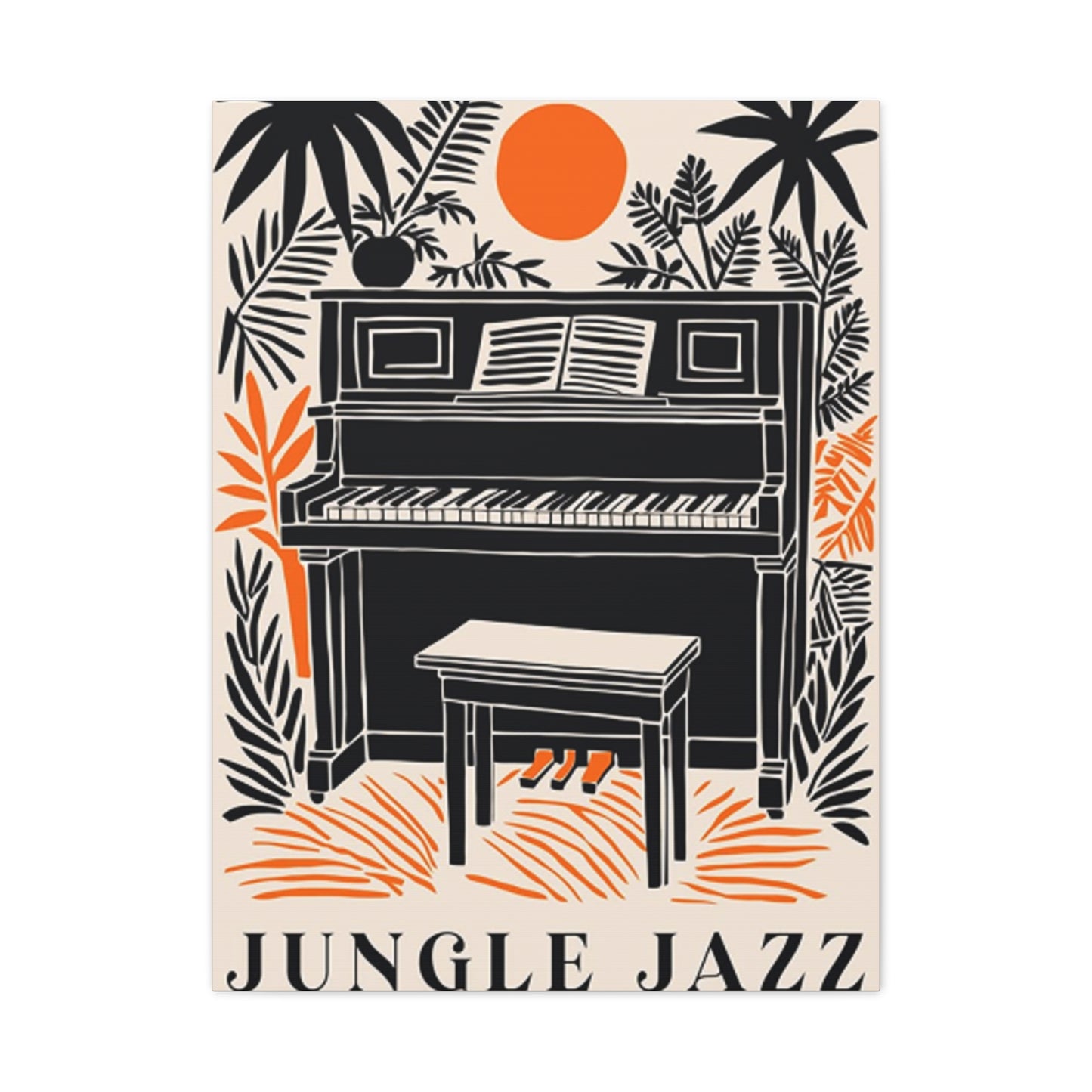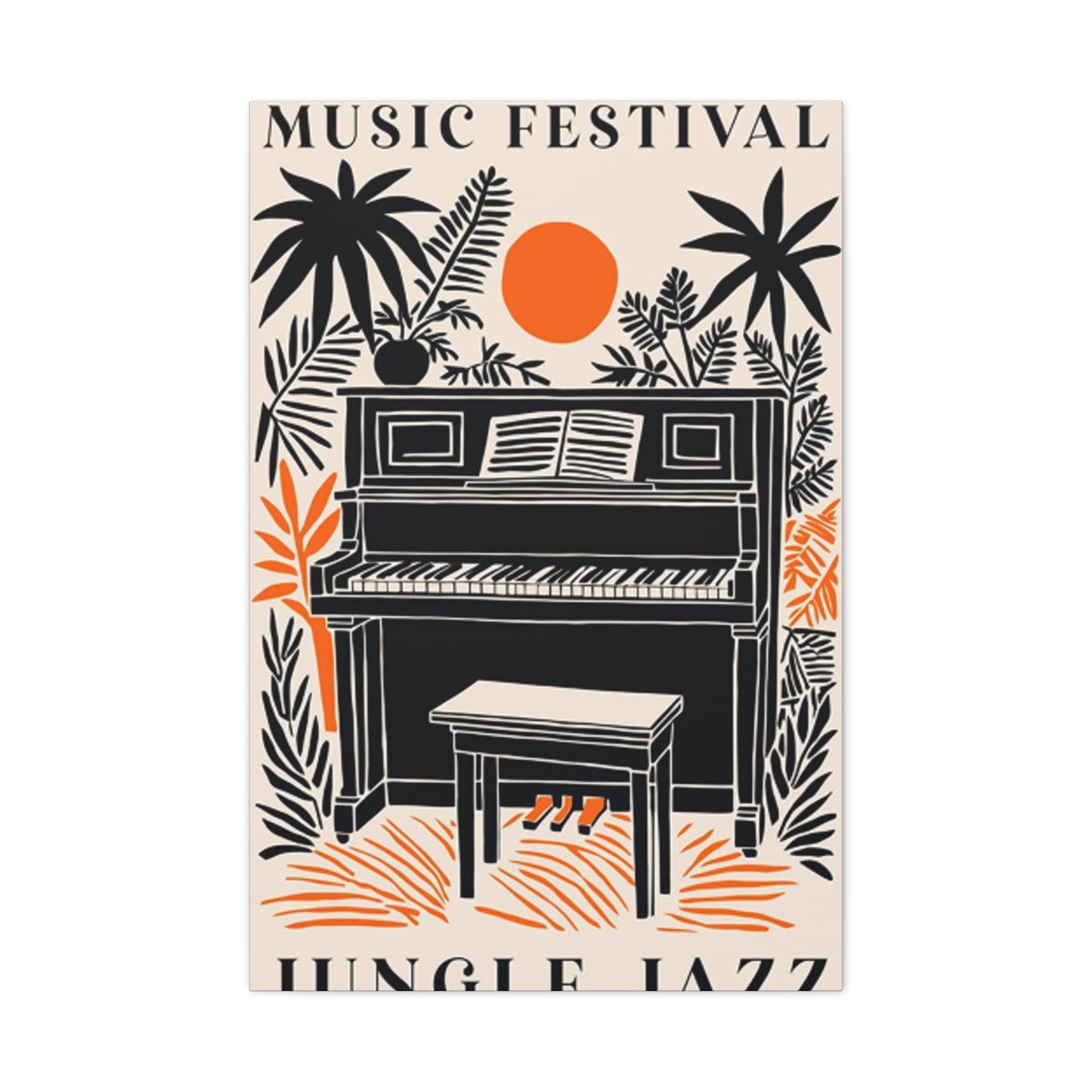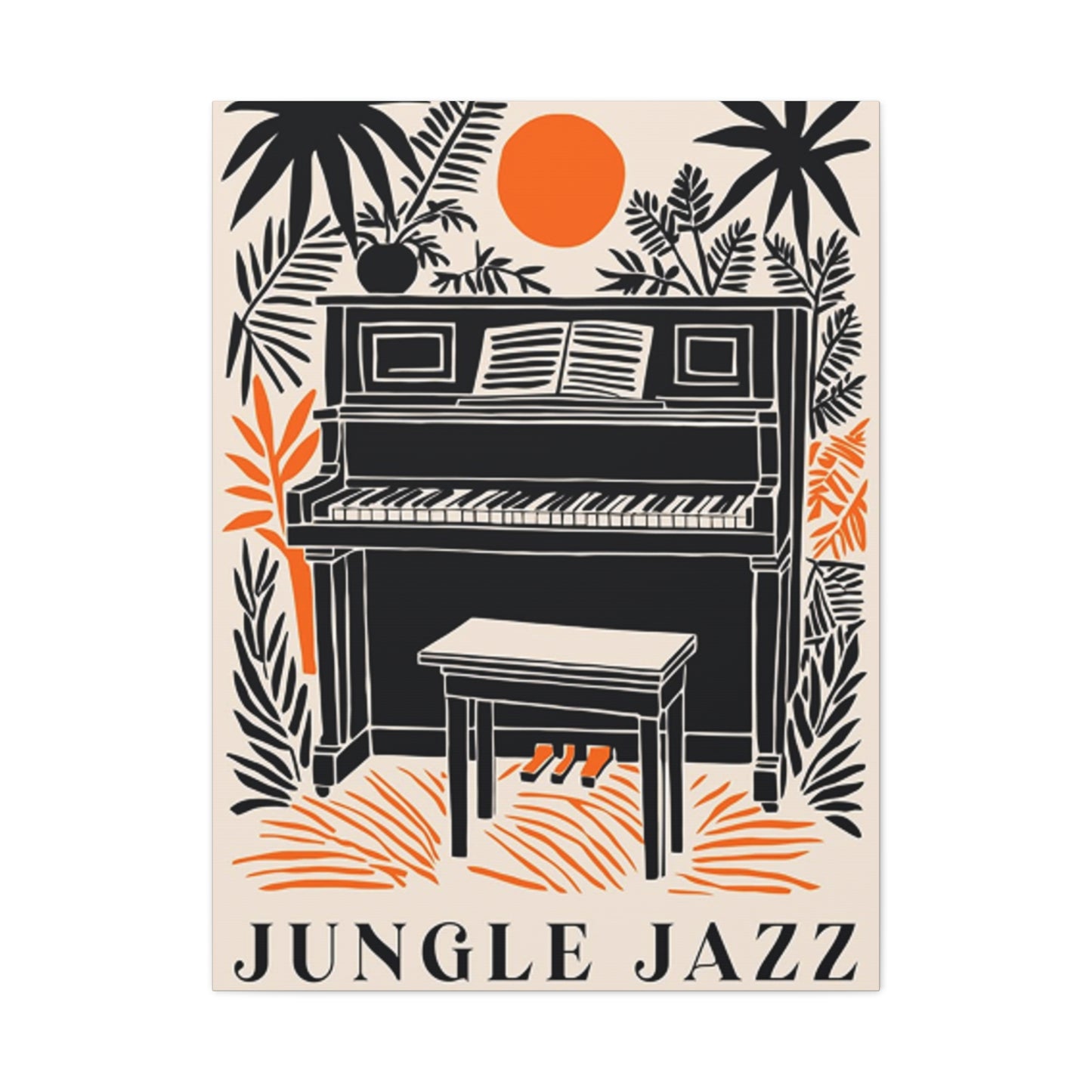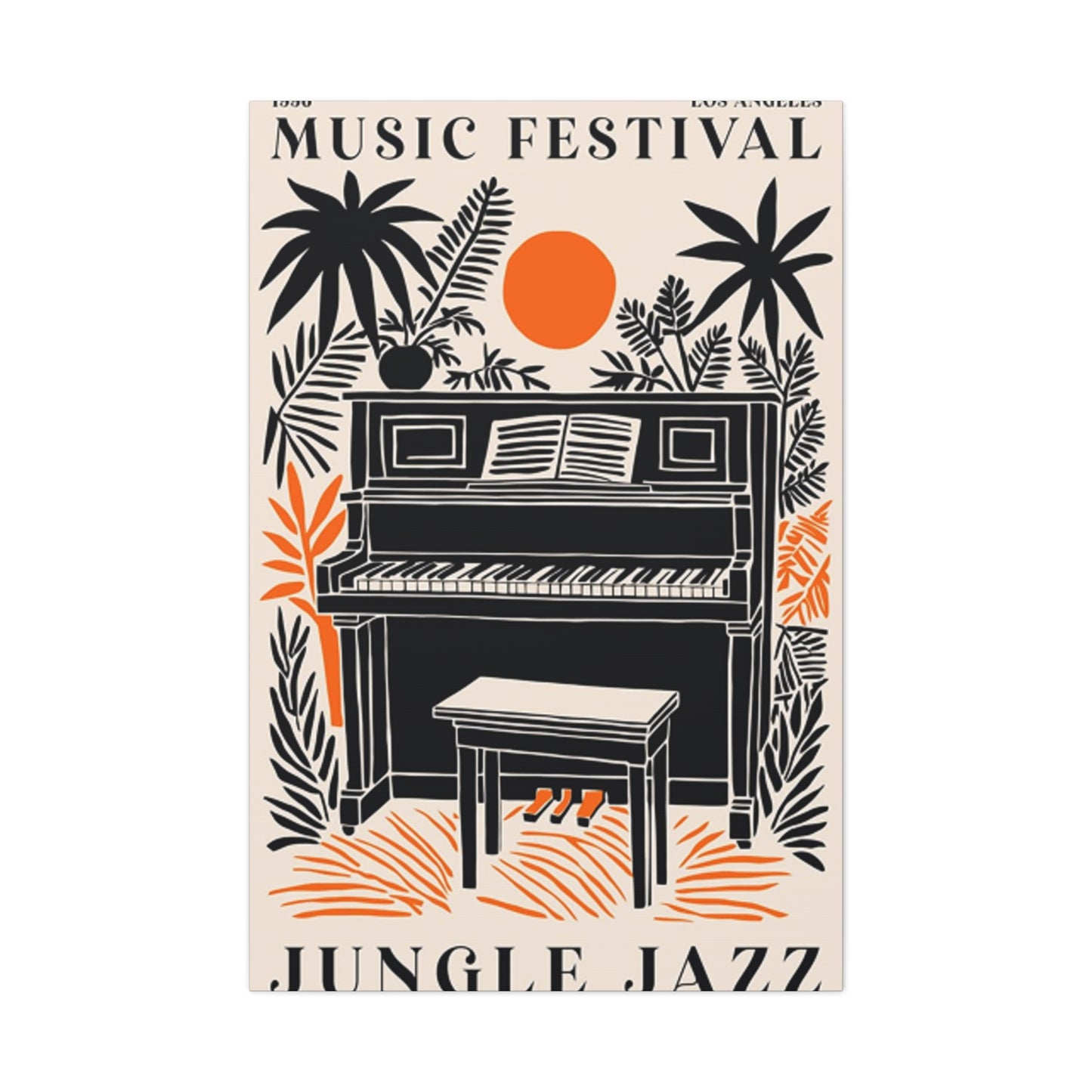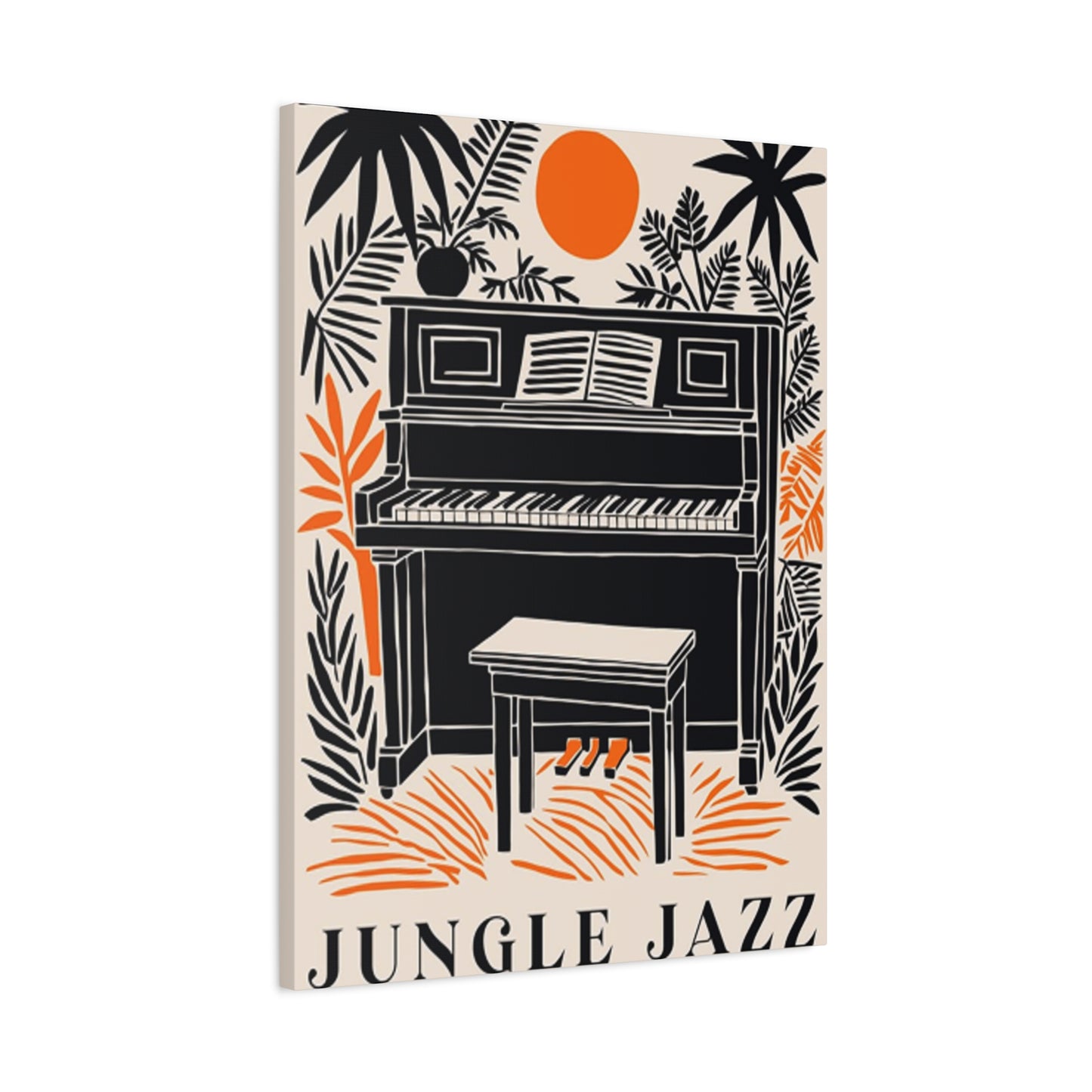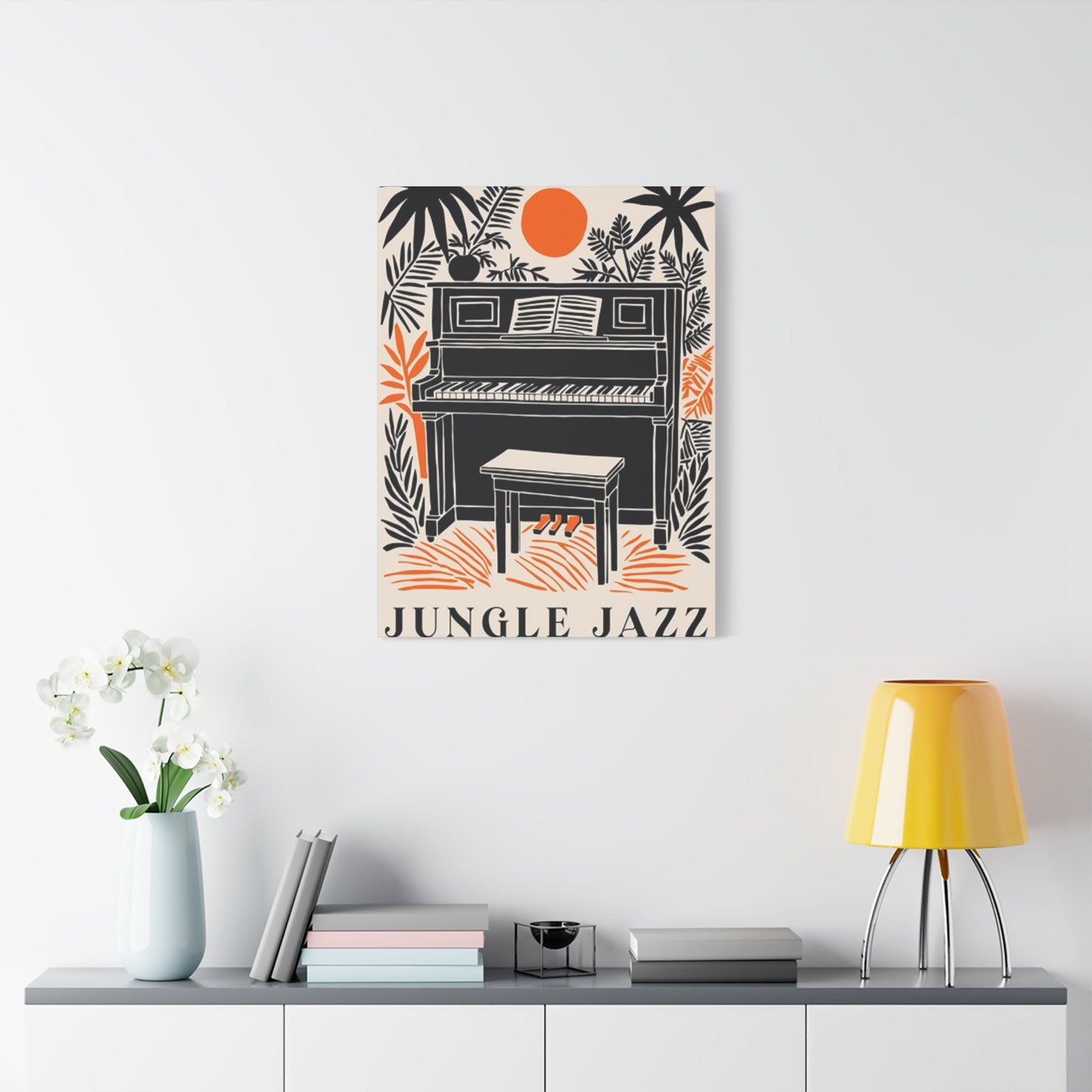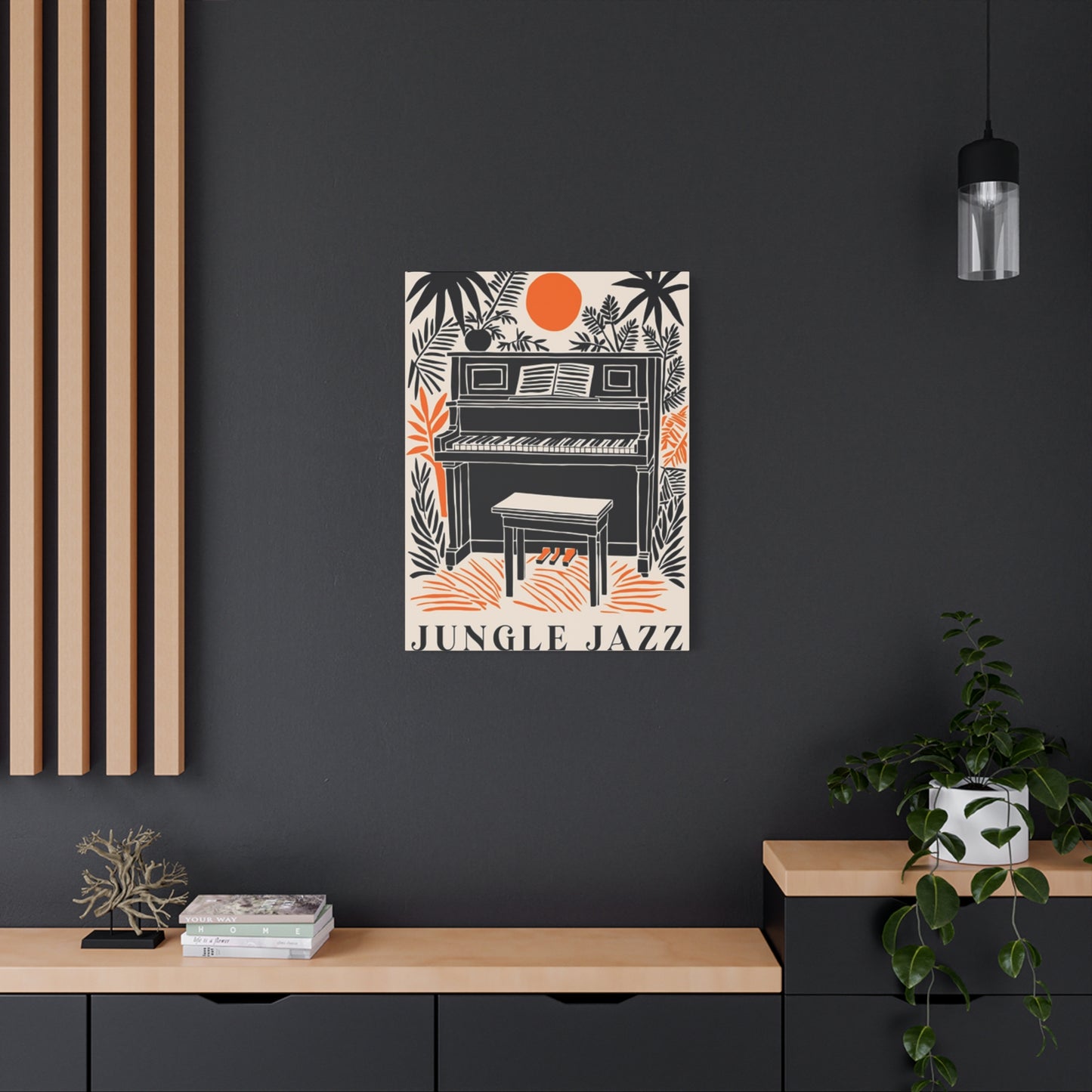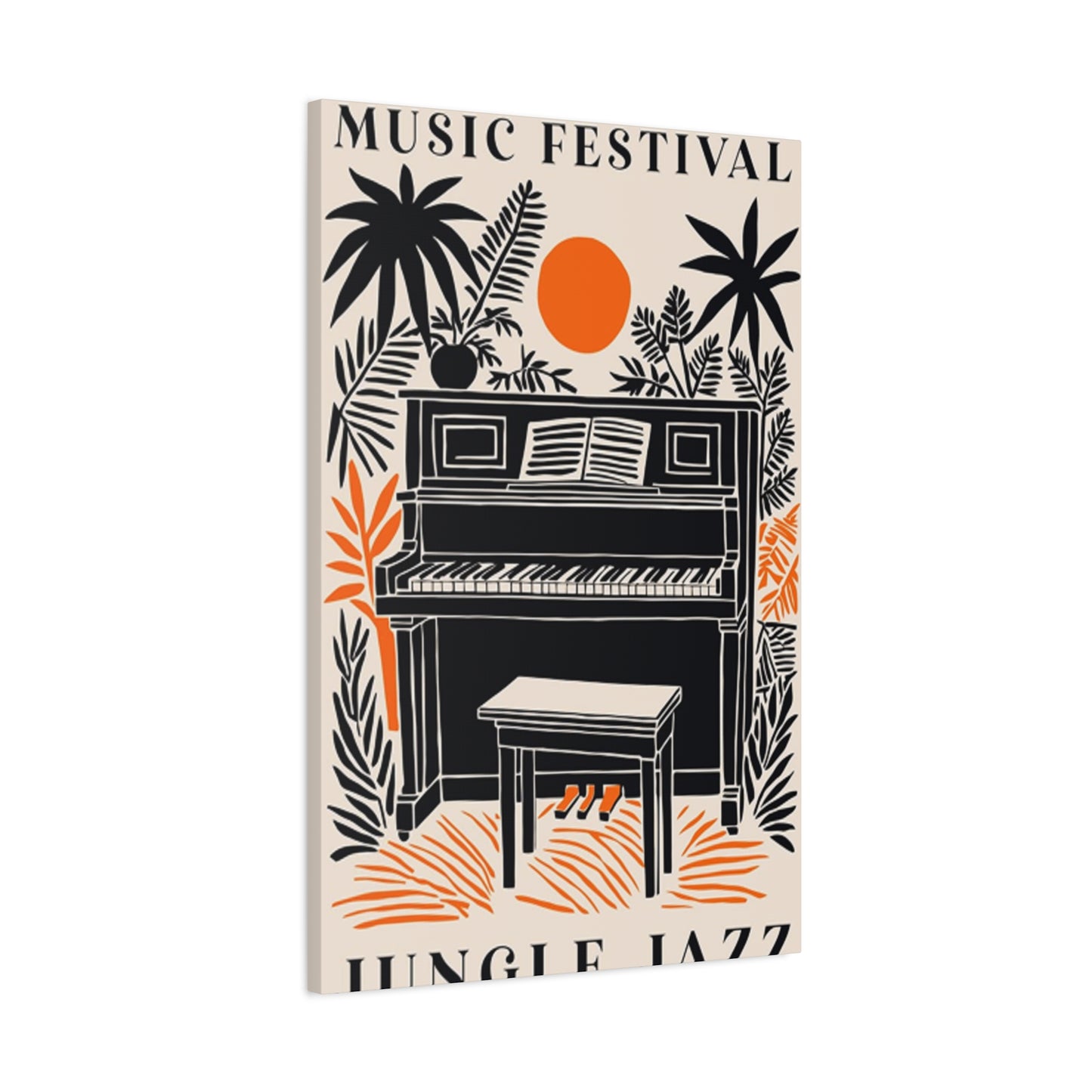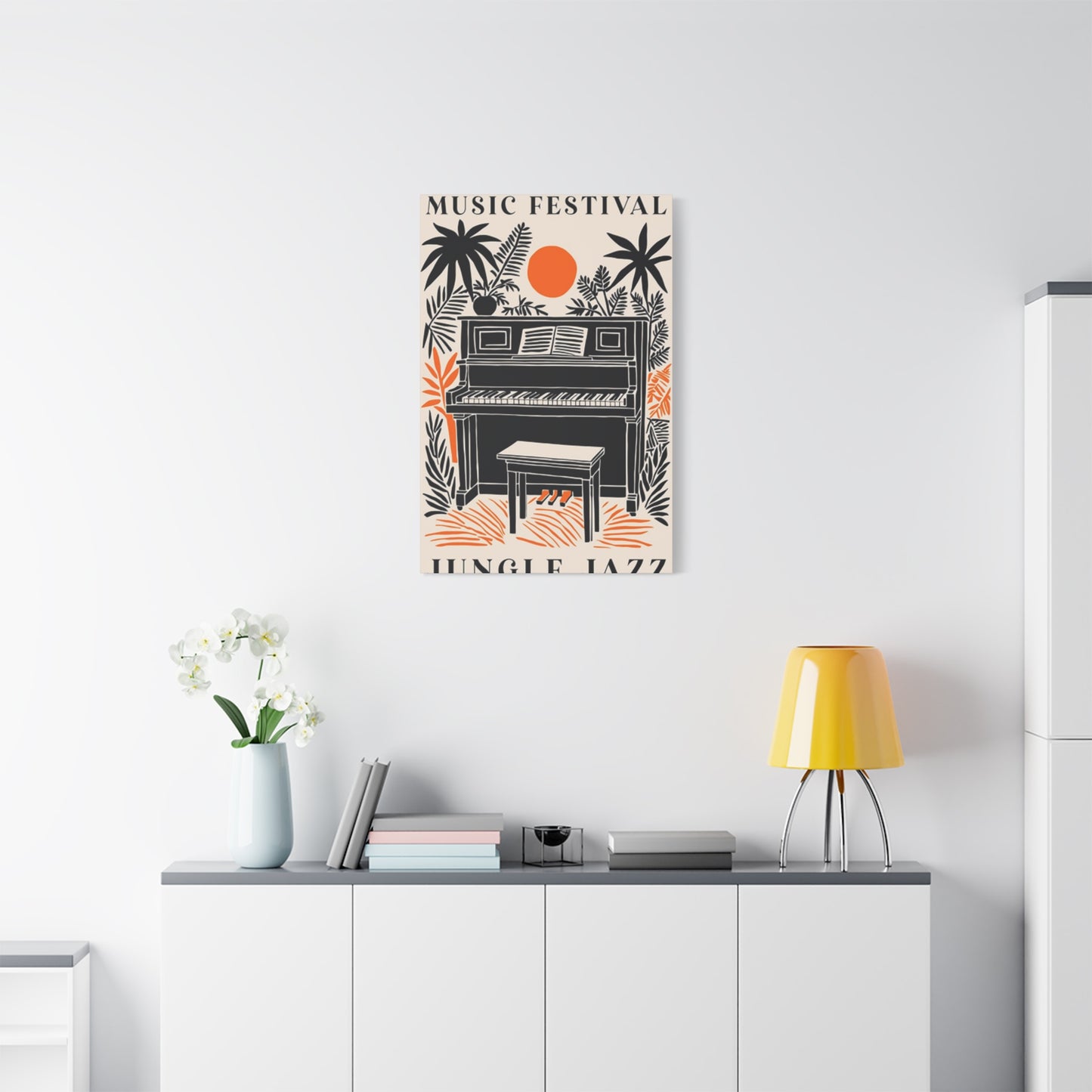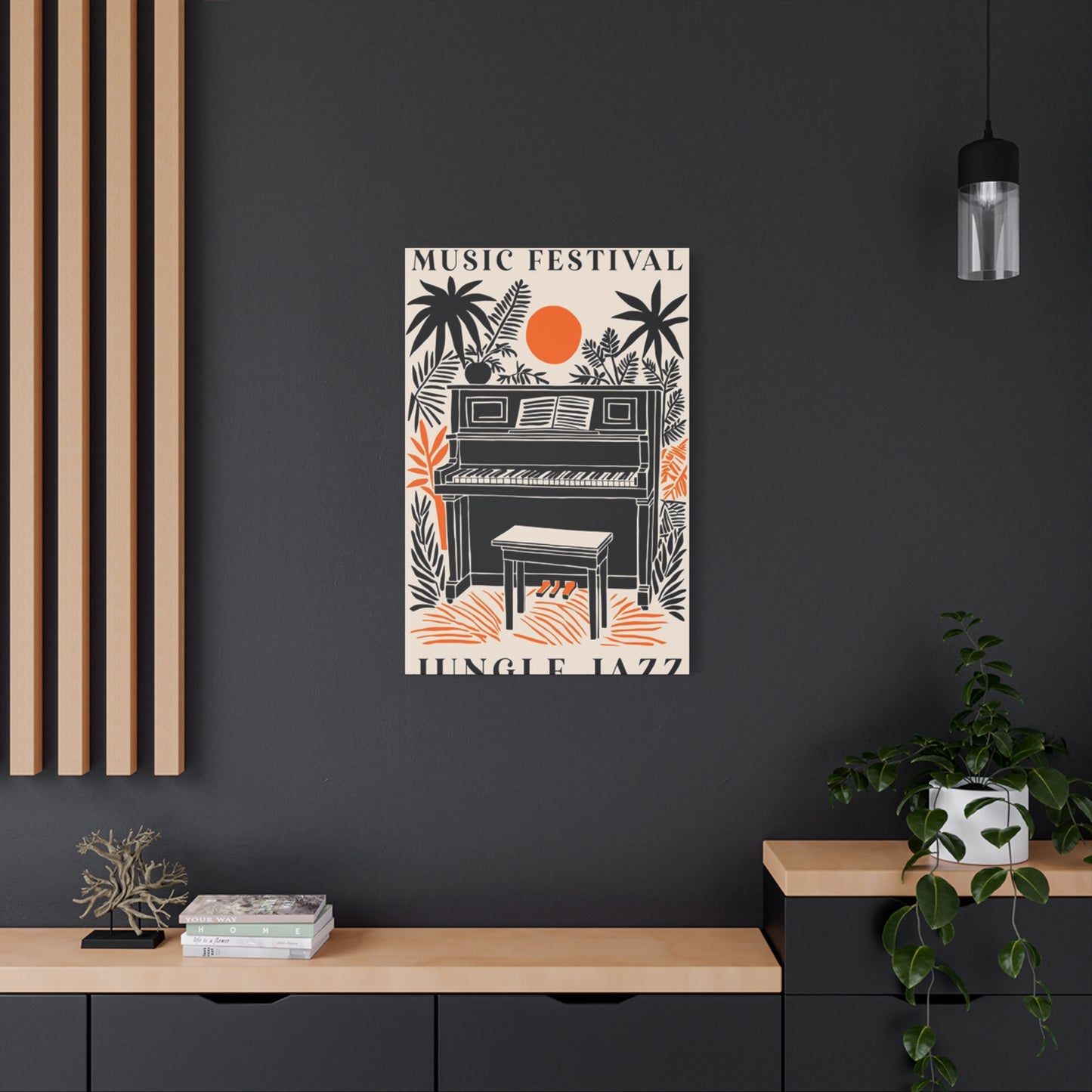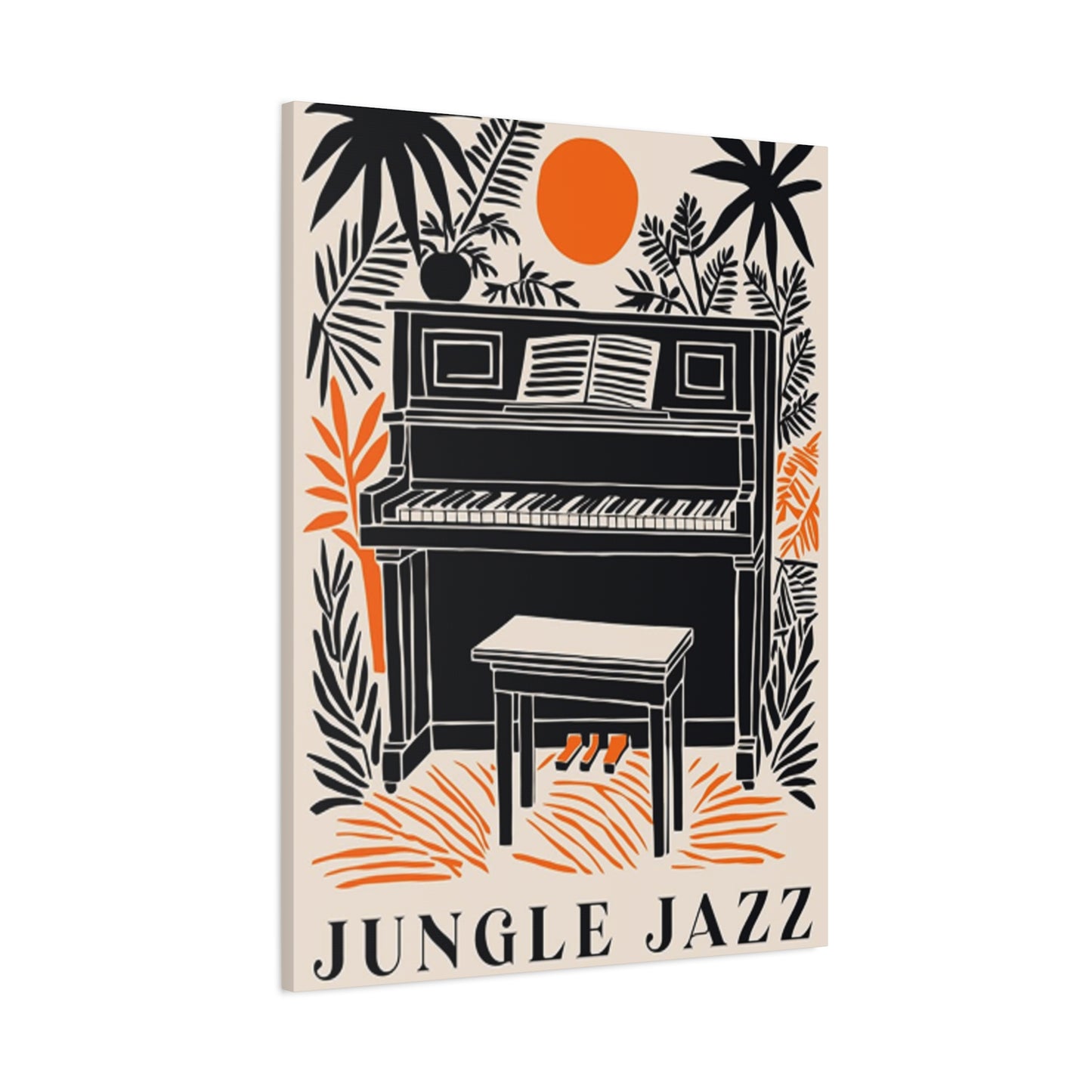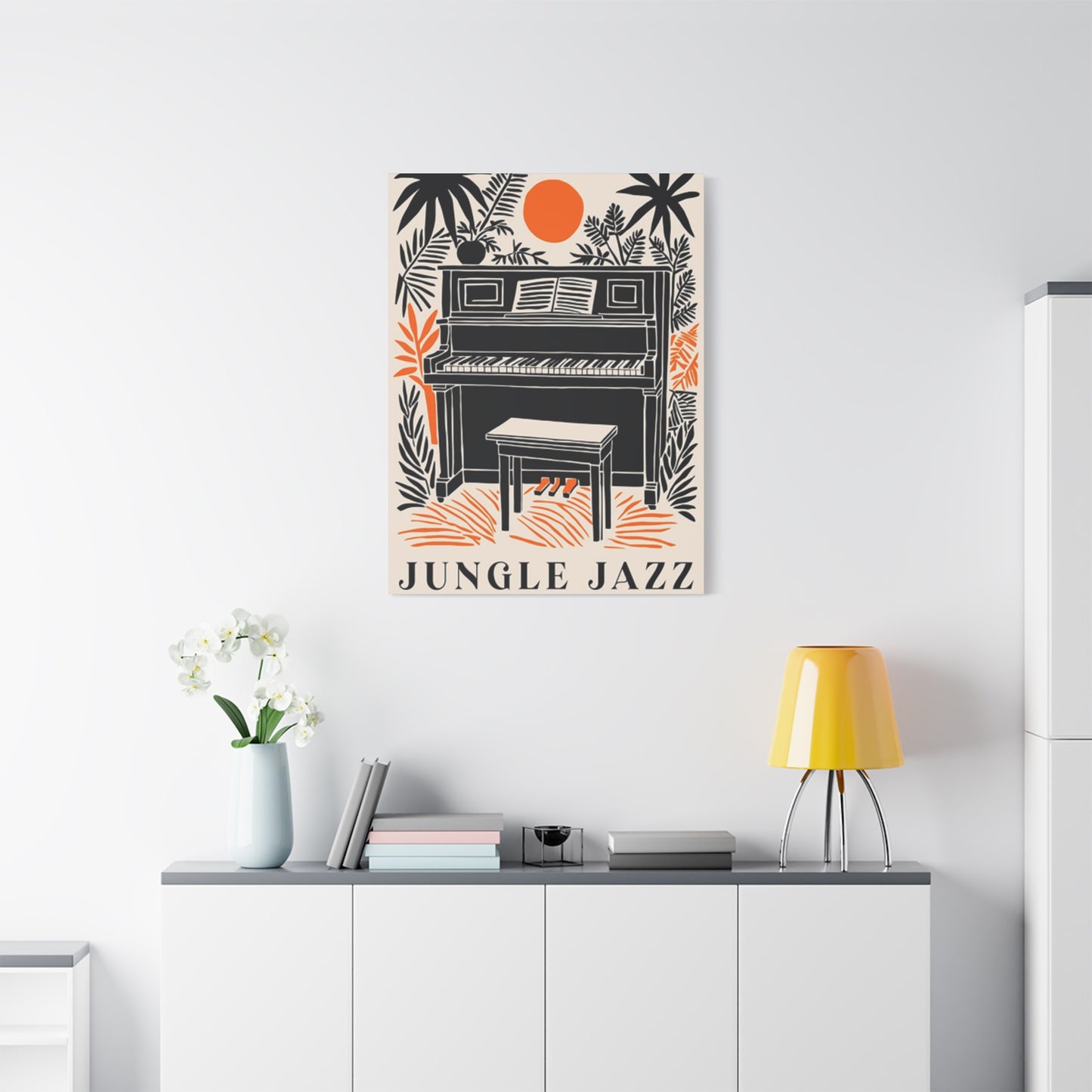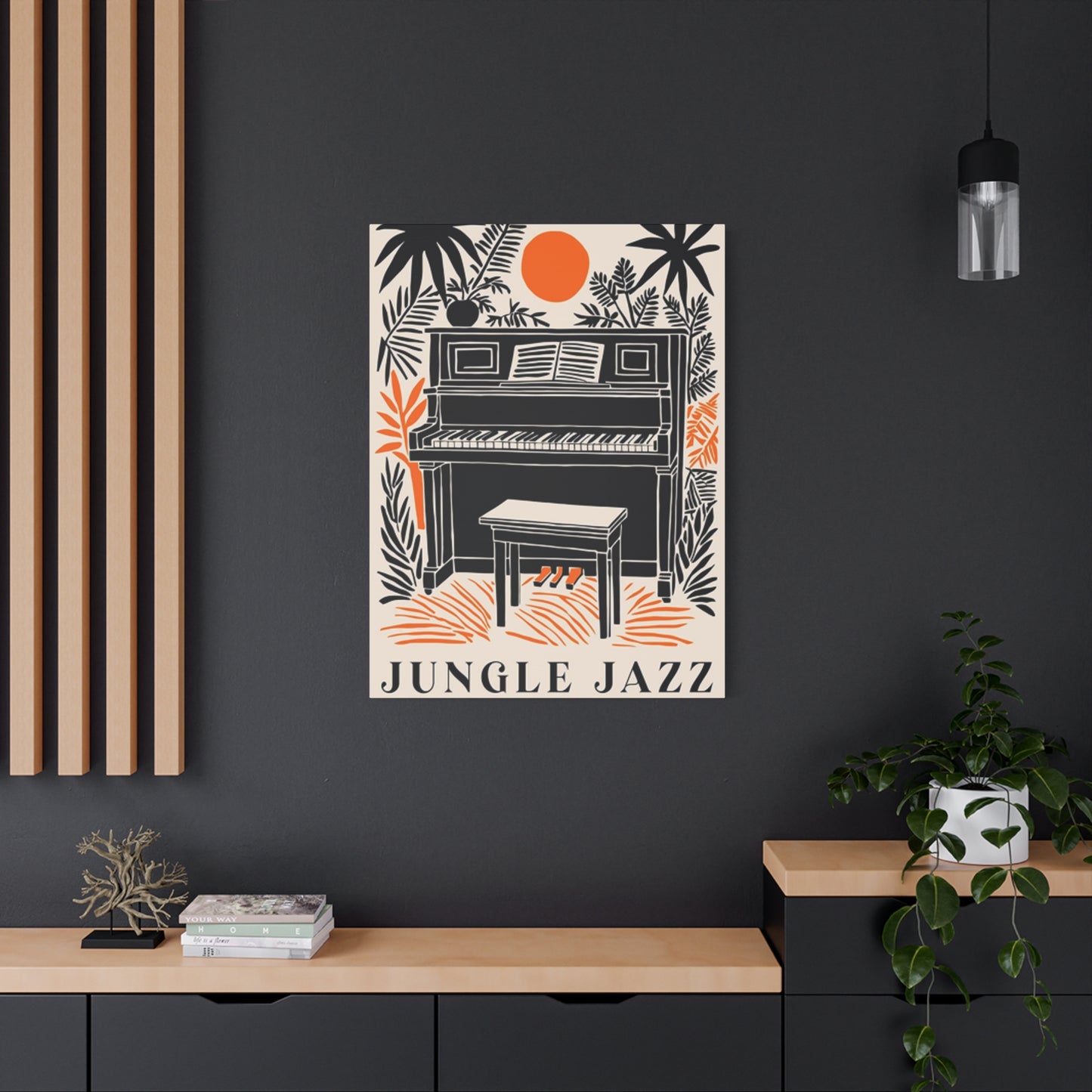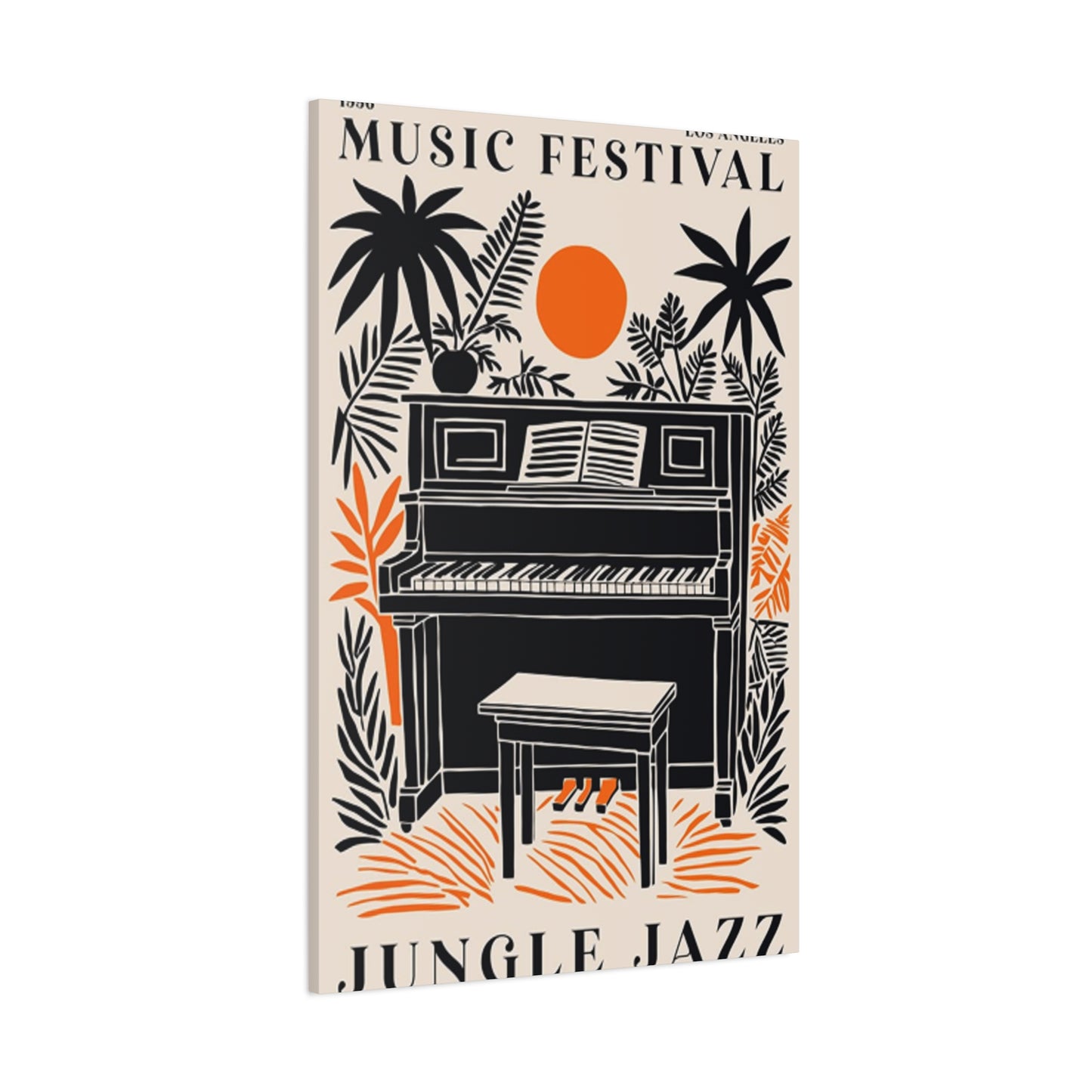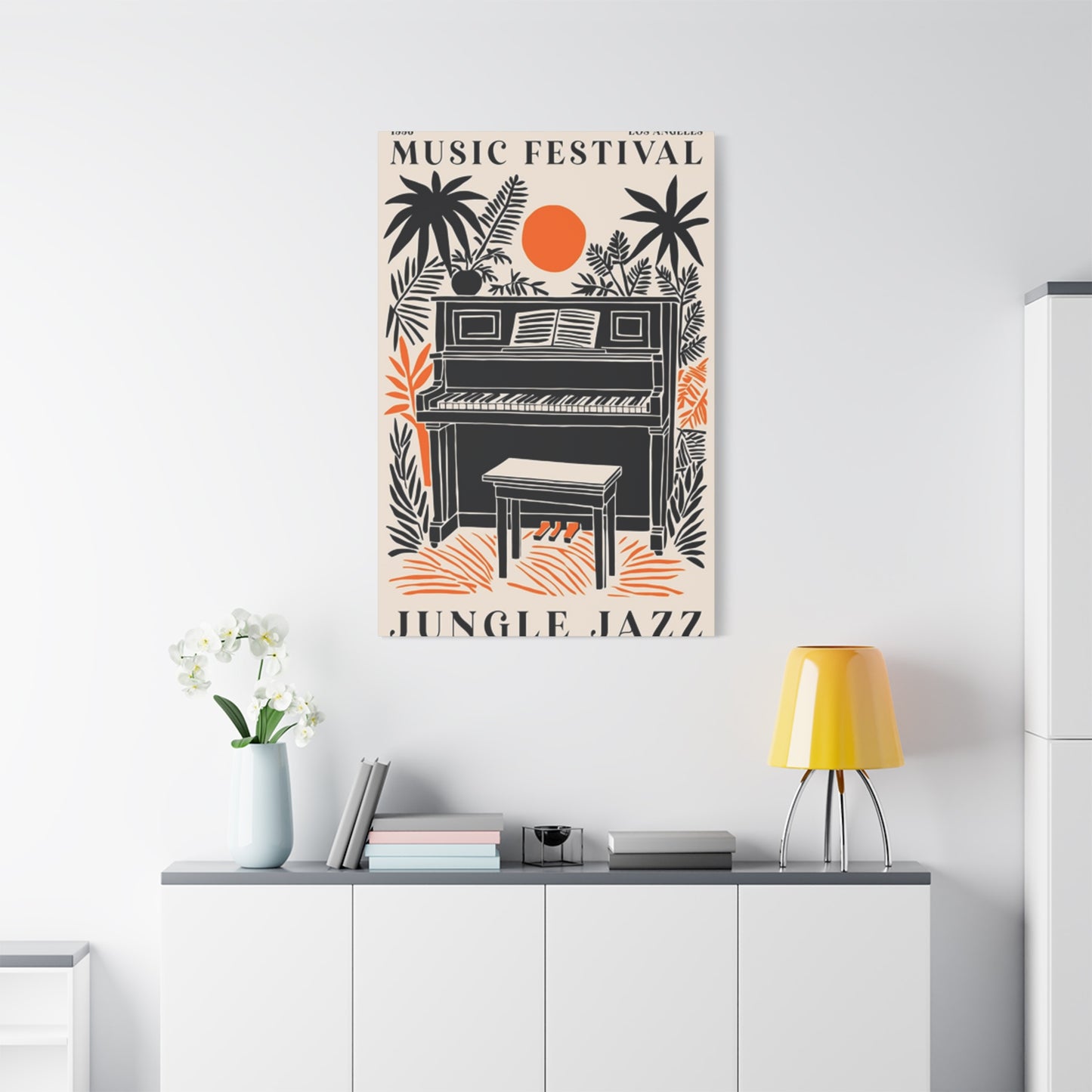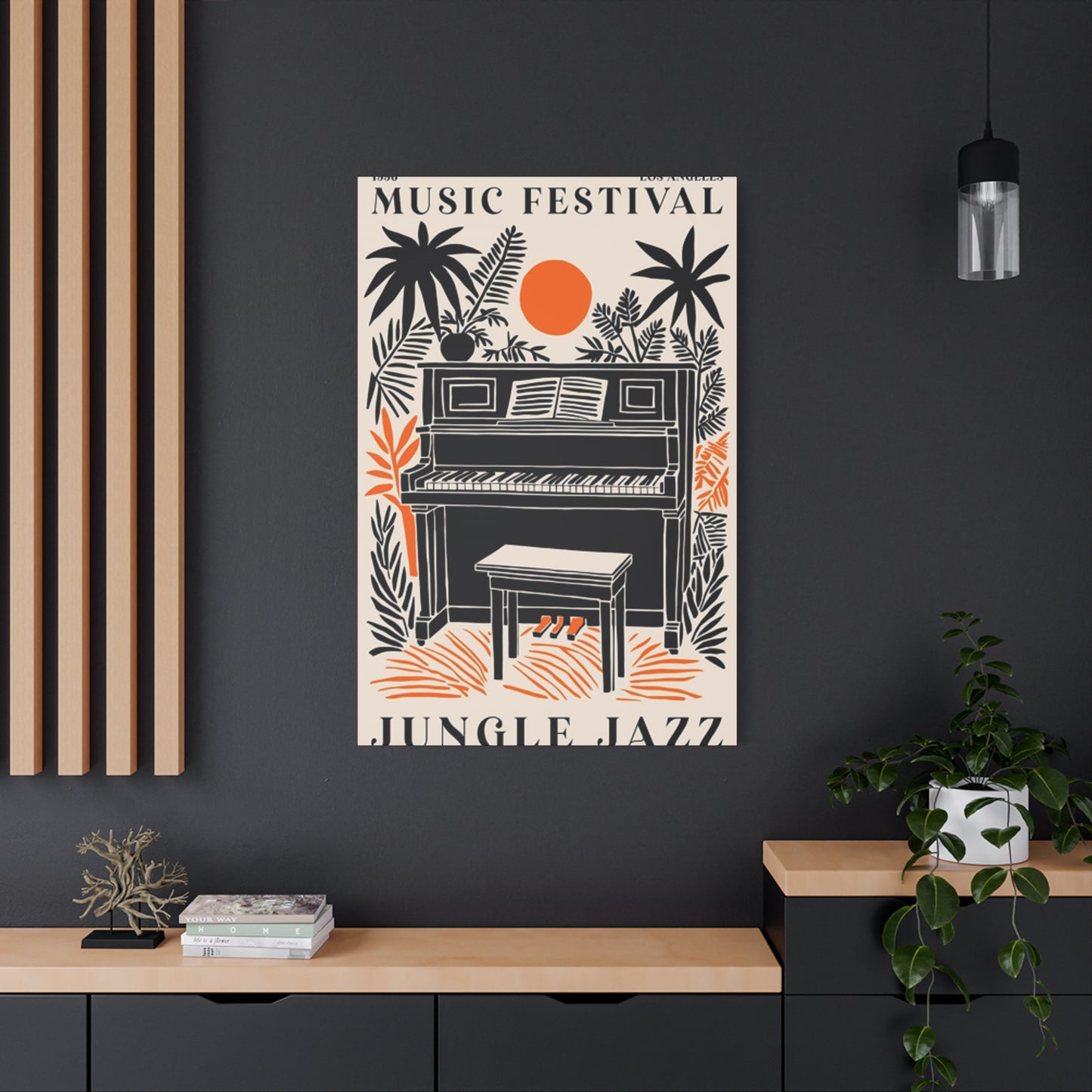Jungle Jazz Wall Art: Creating Musical Paradise in Your Living Environment
The fusion of tropical wilderness aesthetics with smooth musical rhythms has emerged as one of the most captivating trends in contemporary home decoration. Jungle jazz wall art represents a revolutionary approach to transforming living environments, combining the untamed beauty of lush rainforests with the sophisticated allure of jazz culture. This artistic movement transcends traditional boundaries, offering homeowners an opportunity to create immersive environments that celebrate both nature's raw power and music's emotional depth.
The appeal of this artistic genre lies in its ability to transport viewers into a world where exotic melodies intertwine with verdant landscapes. Each piece serves as a portal to an imaginary realm where musical instruments rest among tropical foliage, wild creatures become impromptu performers, and every corner pulses with rhythmic energy. These artworks don't merely decorate walls; they transform entire rooms into sanctuaries of creativity and natural wonder.
Exploring the Rich Heritage of Musical Nature Artwork
The concept of combining natural elements with musical themes has deep historical roots that extend far beyond contemporary trends. Ancient civilizations recognized the intrinsic connection between environmental sounds and human-created melodies, often depicting musicians alongside natural settings in their artistic works. Egyptian tomb paintings frequently showed performers in garden settings, while Greek pottery celebrated the harmony between pastoral scenes and musical expression.
During the Renaissance period, artists began exploring more complex relationships between nature and music. Painters like Arcimboldo created portraits using natural elements, while others depicted concerts in forest clearings and musical gatherings in elaborate gardens. These early works established the foundation for what would eventually evolve into modern jungle jazz wall art, demonstrating humanity's enduring fascination with the intersection of natural beauty and musical creativity.
The emergence of jazz music in the early twentieth century brought new dimensions to this artistic tradition. Jazz's improvisational nature and emphasis on individual expression resonated with artists who sought to capture similar qualities in visual form. The genre's association with nightlife, urban sophistication, and cultural revolution provided rich material for artistic interpretation, particularly when combined with exotic tropical imagery that suggested escape from urban constraints.
Colonial expansion and increased global travel during the nineteenth and early twentieth centuries introduced Western audiences to tropical landscapes and exotic wildlife. These new visual vocabularies merged with existing musical traditions to create unprecedented artistic possibilities. Artists began experimenting with ways to visualize the sounds of distant lands, leading to increasingly sophisticated approaches to combining musical and natural elements in single compositions.
Behind Musical Environmental Artwork
Understanding the psychological impact of jungle jazz wall art requires examining how humans respond to both musical and natural stimuli. Research in environmental psychology demonstrates that exposure to natural imagery can reduce stress levels, improve cognitive function, and enhance overall well-being. Similarly, musical elements in visual art can trigger emotional responses and create associations with specific moods or memories.
The combination of these elements creates a synesthetic experience where viewers simultaneously process visual, auditory, and emotional information. The brain's natural tendency to seek patterns and connections allows people to "hear" the implied music in jungle scenes while "feeling" the tropical atmosphere suggested by jazz-inspired imagery. This multi-sensory engagement makes jungle jazz wall art particularly effective at creating immersive environmental experiences.
Color psychology plays a crucial role in the effectiveness of these artworks. The vibrant greens of tropical vegetation evoke feelings of growth, renewal, and vitality, while the warm golds and deep blues often associated with jazz create sensations of sophistication and relaxation. When these color palettes combine, they produce environments that feel both energizing and calming, dynamic yet harmonious.
The psychological benefits extend to social interactions as well. Jungle jazz wall art often serves as conversation starters, providing guests with rich visual material to discuss and interpret. The complexity and layered meaning in these pieces encourage prolonged engagement, creating opportunities for meaningful discussions about art, music, nature, and personal experiences.
Contemporary Artists Revolutionizing Musical Nature Imagery
Today's artists working in jungle jazz wall art bring diverse backgrounds and innovative techniques to their practice. Many combine traditional painting methods with digital manipulation, creating hybrid works that push the boundaries of conventional artistic categories. These contemporary creators draw inspiration from various sources, including vintage album covers, wildlife photography, botanical illustrations, and ethnographic art from tropical regions.
Some artists focus on photorealistic depictions of musical instruments nestled within meticulously rendered jungle settings. These works often feature saxophones hanging from vines, pianos overgrown with exotic flowers, or drums crafted from natural materials. The technical skill required to achieve convincing integration of these disparate elements demands exceptional artistic ability and deep understanding of both subjects.
Other contemporary artists embrace more abstract approaches, using color, form, and texture to suggest rather than literally depict the relationship between jungle environments and jazz music. These works might employ swirling patterns reminiscent of musical notation combined with organic forms that suggest tropical growth patterns. The resulting pieces invite viewers to engage their imagination and create personal interpretations of the artist's vision.
Mixed media approaches have gained particular popularity among artists working in this genre. Combining traditional painting with collage elements, three-dimensional objects, and digital components allows for unprecedented creative possibilities. Some artists incorporate actual musical instruments or fragments into their pieces, while others use textured materials that evoke the tactile qualities of both jungle environments and musical surfaces.
Color Palettes That Bring Musical Wilderness to Life
The selection and combination of colors in jungle jazz wall art requires sophisticated understanding of both natural color relationships and the emotional associations of different hues. Successful pieces typically employ rich, saturated colors that capture the intensity of tropical environments while maintaining the sophisticated elegance associated with jazz culture.
Green serves as the foundation for most jungle-inspired color schemes, but artists working in this genre employ an extraordinary range of green variations. From the deep emerald of rainforest canopies to the bright lime of new growth, from the blue-green of certain leaves to the yellow-green of sunlit foliage, each shade contributes specific emotional and visual qualities to the overall composition.
Complementary warm colors provide essential balance and visual interest. The golden yellows of brass instruments, the warm browns of wooden surfaces, and the rich oranges of tropical sunsets create vibrant contrasts that energize compositions while maintaining natural harmony. These warm tones also evoke the intimate lighting associated with jazz venues and the golden hour illumination common in tropical settings.
Blue elements, from the deep navy of night skies to the brilliant turquoise of tropical waters, add depth and sophistication to jungle jazz compositions. These colors often appear in clothing worn by depicted figures, in the finishes of musical instruments, or in atmospheric effects that suggest the mysterious qualities of both jungle environments and late-night jazz performances.
Purple and magenta accents frequently appear in jungle jazz wall art, representing the exotic flowers found in tropical environments and the sophisticated lighting often associated with jazz clubs. These colors bridge the gap between natural and artificial elements, suggesting the transformation of raw natural beauty into refined artistic expression.
Integrating Musical Instruments into Natural Settings
The artistic challenge of believably placing musical instruments within jungle environments requires careful consideration of scale, lighting, materials, and narrative context. Successful integration creates the impression that these human-made objects belong naturally within their wild surroundings, rather than appearing as foreign intrusions.
Scale relationships play a crucial role in creating convincing compositions. Instruments must appear appropriately sized relative to surrounding vegetation and wildlife. This often involves careful perspective work and understanding of how distance affects the perceived size of objects. Some artists deliberately play with scale to create surreal effects, depicting tiny musicians performing for enormous leaves or massive instruments dwarfing their jungle surroundings.
Lighting consistency helps unify disparate elements within single compositions. Jungle environments typically feature complex lighting patterns created by filtered sunlight passing through multiple layers of vegetation. Successful jungle jazz wall art replicates these lighting conditions across both natural and manufactured elements, creating believable integration through shared illumination characteristics.
Material considerations involve showing how instruments might weather or adapt to tropical conditions. Some artists depict instruments showing signs of humidity exposure, vine growth, or other environmental effects. Others imagine instruments crafted from natural materials that blend seamlessly with their surroundings. These approaches add narrative depth while enhancing visual coherence.
Contextual integration involves creating plausible reasons for instruments to exist within jungle settings. Some compositions suggest abandoned instruments discovered by wildlife, while others depict active musical performances taking place in natural amphitheaters. The most successful pieces create rich narrative possibilities that invite viewers to imagine the stories behind the scenes.
Wildlife as Musicians in Jungle Jazz Compositions
The anthropomorphization of wildlife in jungle jazz wall art creates opportunities for whimsical, thought-provoking, and emotionally engaging compositions. Animals depicted as musicians tap into viewers' natural affinity for both wildlife and music while creating memorable characters that personalize abstract artistic concepts.
Primates, with their human-like hands and expressive faces, naturally lend themselves to musical roles in jungle jazz artwork. Chimpanzees, orangutans, and various monkey species frequently appear as instrumentalists, their natural dexterity making their musical activities seem plausible. Artists often exaggerate these creatures' expressions to convey the emotional intensity associated with jazz performance.
Birds offer unique opportunities for musical integration due to their natural vocal abilities. Parrots, toucans, and other tropical birds often appear as singers or wind instrument players in jungle jazz compositions. Their colorful plumage provides natural visual harmony with the vibrant aesthetics typical of this artistic genre.
Large mammals like elephants and jaguars create dramatic focal points in jungle jazz scenes. Elephants' association with memory and intelligence makes them compelling subjects for complex musical compositions, while big cats' grace and power translate well to rhythmic roles. These animals often appear as lead performers or conductors in ensemble scenes.
Reptiles and amphibians contribute to the exotic atmosphere while offering opportunities for creative musical roles. Iguanas might serve as stoic bass players, while colorful frogs could form vocal ensembles. These creatures' unique physical characteristics allow artists to explore unconventional approaches to depicting musical performance.
Rhythm and Movement in Visual Jungle Jazz Art
Creating visual representations of rhythm and movement requires sophisticated understanding of how static images can suggest dynamic processes. Jungle jazz wall art employs various techniques to convey the energetic, improvisational qualities that define jazz music while capturing the constant motion inherent in living ecosystems.
Compositional techniques borrowed from classical art theory help create visual rhythm through repetition, variation, and emphasis. Repeated elements like leaves, musical notes, or animal figures establish visual beats that viewers unconsciously follow. Variations in size, color, or orientation of these repeated elements create syncopation and complexity analogous to jazz rhythms.
Implied motion through positioning and gesture brings static images to life. Musicians depicted in mid-performance, with instruments positioned to suggest active playing, create sense of ongoing activity. Similarly, animals shown in characteristic poses associated with their natural behaviors suggest continuous movement even within frozen moments.
Abstract elements like swirling lines, flowing forms, and rhythmic patterns can represent musical phrases, improvised solos, or the organic growth patterns found in jungle environments. These visual metaphors allow artists to directly translate auditory experiences into visual language, creating more sophisticated connections between musical and natural themes.
Color progression and tonal variation across compositions create visual equivalents to musical dynamics. Gradual shifts from dark to light or subtle to vibrant can represent crescendos, while abrupt color changes might suggest sudden musical accents or environmental shifts.
Creating Atmospheric Depth in Musical Nature Scenes
Atmospheric depth in jungle jazz wall art involves layering visual elements to create convincing three-dimensional environments that immerse viewers in complex, multi-leveled scenes. This technique transforms flat wall surfaces into windows opening onto rich, detailed worlds where music and nature coexist.
Foreground elements establish immediate visual interest and provide entry points for viewer engagement. These might include close-up details of musical instruments, prominent animal characters, or distinctive vegetation that frames the composition. Successful foreground elements invite closer examination while leading the eye toward deeper compositional layers.
Middle ground areas typically contain the primary narrative elements of jungle jazz compositions. This is where the main musical performances occur, where key character interactions take place, and where the central themes of the artwork receive their fullest expression. The middle ground must balance detail with clarity, providing enough visual information to support the composition's narrative while maintaining overall compositional harmony.
Background elements create context and atmosphere without overwhelming foreground activities. Distant jungle landscapes, atmospheric effects, and subtle environmental details contribute to the overall mood while providing spatial depth. These elements often employ techniques like atmospheric perspective, where distant objects appear lighter and less detailed than nearby elements.
Overlapping forms and strategic use of transparency create additional depth effects. Vegetation partially obscuring distant elements, shadows cast by foreground objects, and the interplay between solid and semi-transparent elements all contribute to convincing spatial relationships within compositions.
The Role of Cultural Fusion in Jungle Jazz Artwork
Jungle jazz wall art inherently involves cultural fusion, combining musical traditions rooted in African American experience with imagery drawn from global tropical environments. This fusion creates opportunities for rich cultural dialogue while requiring sensitivity to the historical and social contexts of both traditions.
The jazz tradition carries deep cultural significance related to creativity, resistance, and cultural expression. Artists working with jazz themes must understand and respect these historical dimensions while finding ways to honor the music's cultural origins. This often involves research into jazz history, prominent musicians, and the social contexts that shaped the genre's development.
Tropical imagery brings its own cultural associations, often derived from colonial encounters, travel literature, and popular media representations. Artists must navigate between celebrating the genuine beauty of tropical environments and avoiding problematic exotic stereotypes. This requires nuanced understanding of how different cultures relate to tropical landscapes and wildlife.
Contemporary jungle jazz wall art increasingly emphasizes authentic cultural exchange over superficial appropriation. Artists collaborate with musicians, study traditional art forms from tropical regions, and engage with communities connected to the cultures they reference. These approaches result in more respectful and culturally informed artworks.
The fusion aspect itself becomes a celebration of cultural hybridity and creative possibility. Rather than simply combining disparate elements, successful jungle jazz artwork creates new cultural expressions that honor multiple traditions while developing unique aesthetic languages.
Digital Techniques Revolutionizing Musical Nature Art
Contemporary digital tools have dramatically expanded the possibilities for creating jungle jazz wall art, allowing artists to achieve effects and combinations previously impossible through traditional methods. These technologies enable unprecedented precision in combining photographic elements, manipulating colors and textures, and creating complex layered compositions.
Digital painting software provides artists with virtually unlimited color palettes and brush options, enabling the creation of highly detailed and precisely controlled effects. Artists can experiment with different approaches to depicting tropical vegetation, testing various techniques for rendering the complex lighting conditions found in jungle environments without committing to permanent decisions.
Photo manipulation and compositing techniques allow artists to combine elements from multiple sources, creating seamless integrations of musicians, instruments, and natural settings. These approaches can produce photorealistic results or deliberately artificial effects, depending on the artist's aesthetic goals and narrative intentions.
Three-dimensional modeling software enables artists to create convincing spatial relationships and lighting effects. Virtual jungle environments can be constructed with precise attention to botanical accuracy, while musical instruments can be modeled and positioned with perfect perspective and proportion. These tools are particularly valuable for planning complex compositions before beginning final artwork creation.
Animation capabilities allow some artists to create moving versions of jungle jazz artwork, bringing static compositions to life through subtle movements, changing lighting, or evolving musical performances. These animated pieces can be displayed on digital screens or incorporated into multimedia installations.
Material Choices for Wall Art
The translation of jungle jazz artwork from digital or painted originals to finished wall art requires careful consideration of printing technologies and material choices. Different approaches yield varying aesthetic results and affect both the artwork's longevity and its visual impact in residential or commercial settings.
Giclée printing on canvas remains the most popular choice for high-quality art reproduction, offering excellent color accuracy and the textural qualities associated with traditional paintings. The canvas texture adds visual interest while the archival quality inks ensure long-term color stability. Various canvas weights and weaves provide different aesthetic effects, from smooth surfaces that emphasize detail to heavily textured options that add dimensional interest.
Metal printing creates striking effects particularly well-suited to jungle jazz artwork's vibrant colors and dynamic compositions. The reflective qualities of aluminum or steel substrates can enhance the luminous qualities of tropical colors while creating subtle dimensional effects as viewing angles change. Metal prints also offer exceptional durability and resistance to fading.
Acrylic printing produces brilliant, saturated colors with extraordinary depth and clarity. The smooth surface and optical clarity of acrylic can create almost three-dimensional effects, particularly effective for compositions with strong atmospheric depth. These prints work especially well in contemporary settings where clean, modern presentation enhances rather than competes with the artwork's organic subject matter.
Paper prints using archival inks and acid-free substrates provide traditional presentation options suitable for framing behind glass. High-quality paper prints can achieve excellent detail resolution and offer the most economical approach to acquiring jungle jazz wall art. Various paper textures, from smooth photo papers to textured fine art papers, provide different aesthetic effects.
Size Considerations and Scaling Effects
The size of jungle jazz wall art significantly affects its visual impact and the viewer's relationship to the depicted scenes. Different scales create different viewing experiences, from intimate encounters with detailed compositions to immersive environments that surround viewers with tropical musical worlds.
Large-scale pieces create dramatic focal points that can transform entire rooms. Wall-sized jungle jazz murals immerse viewers in depicted environments, creating the sensation of stepping into tropical concert venues or discovering musical performances in remote jungle clearings. These pieces work particularly well in entertainment areas, music rooms, or other locations where dramatic impact is desired.
Medium-sized artworks provide substantial visual presence while maintaining versatility in placement options. These pieces can serve as central elements in room designs without overwhelming other decorative elements. Medium scales work well for detailed compositions where viewers can appreciate intricate elements while still experiencing the overall compositional impact.
Small-scale pieces allow for detailed examination and work well in intimate settings or as part of larger collections. These works might focus on specific elements like individual musical instruments or single animal characters, providing opportunities for close viewing and detailed appreciation of artistic techniques.
Series of related pieces at various scales can create rich, layered installations that build complex narratives across multiple artworks. A combination of large background pieces with smaller detailed elements can create museum-quality displays that evolve as viewers move through the environment.
Lighting Considerations for Musical Jungle Artwork
Proper lighting is essential for maximizing the visual impact of jungle jazz wall art and ensuring accurate color reproduction. The complex color relationships and atmospheric effects typical of this artistic genre require carefully planned illumination to achieve optimal presentation results.
Natural daylight provides the most accurate color reproduction but varies throughout the day and across seasons. Positioning jungle jazz artwork to receive consistent northern light or filtered eastern exposure can provide stable illumination while avoiding the harsh contrasts and color shifts associated with direct sunlight.
LED track lighting systems offer precise control over illumination direction and intensity while producing minimal heat that could damage artwork over time. Color-accurate LED fixtures with high Color Rendering Index ratings ensure faithful reproduction of the subtle color relationships crucial to jungle jazz artwork's visual effectiveness.
Picture lighting fixtures mounted directly above or below artworks provide focused illumination that emphasizes texture and detail while creating dramatic presentation effects. These fixtures work particularly well with pieces featuring strong three-dimensional elements or complex layered compositions.
Ambient room lighting should complement rather than compete with artwork illumination. Warm, diffused lighting creates atmosphere that enhances the tropical and musical themes while avoiding harsh contrasts that could detract from the artwork's visual impact.
Seasonal Adaptations and Rotating Displays
The tropical nature of jungle jazz wall art makes it particularly suitable for seasonal rotation and adaptation, allowing homeowners to adjust their decorative environments throughout the year while maintaining consistent thematic elements.
Summer displays might emphasize the most vibrant and energetic aspects of jungle jazz artwork, featuring bright tropical colors and active musical performances. These pieces can enhance the season's natural energy while providing visual cooling effects through association with lush, shaded jungle environments.
Winter presentations might focus on warmer color palettes and more intimate musical scenes, providing psychological warmth and escape from harsh weather conditions. Pieces featuring evening performances or cozy jungle clearings can create sanctuary-like atmospheres during cold months.
Spring rotations can celebrate renewal and growth themes inherent in jungle imagery while incorporating musical elements that suggest awakening and energy. Fresh greens and bright floral elements combined with uplifting musical themes support the season's psychological associations.
Autumn displays might emphasize the sophisticated, mature aspects of jazz culture while incorporating the rich, warm colors associated with tropical sunsets and exotic fruits. These combinations create environments suitable for contemplation and appreciation of artistic complexity.
Collecting and Curating Musical Nature Artwork
Building a collection of jungle jazz wall art requires understanding of artistic quality, thematic coherence, and long-term aesthetic development. Successful collectors develop expertise in recognizing exceptional examples of the genre while maintaining clear vision for their collection's overall direction and growth.
Artist research forms the foundation of informed collecting decisions. Understanding individual artists' backgrounds, technical approaches, and artistic development helps collectors make choices that will provide lasting satisfaction and potential value appreciation. Many jungle jazz artists have diverse backgrounds in music, travel, or natural sciences that inform their artistic perspectives.
Thematic coherence helps collections achieve greater impact than random acquisitions of appealing individual pieces. Collectors might focus on specific aspects of jungle jazz art, such as particular animal subjects, specific musical instruments, or certain cultural fusion approaches. Clear thematic direction guides acquisition decisions while allowing for growth and evolution.
Quality considerations extend beyond immediate visual appeal to include technical execution, conceptual depth, and materials longevity. Higher-quality pieces typically demonstrate superior integration of musical and natural elements, sophisticated color relationships, and innovative approaches to common themes.
Investment potential varies widely within the jungle jazz art market. Original works by established artists typically hold value better than prints or works by unknown creators. However, the primary motivation for collection should be personal enjoyment rather than financial speculation.
Custom Commissions and Personalized Musical Art
Custom commissioned jungle jazz wall art offers opportunities to create personalized artworks that reflect individual musical tastes, favorite animals, or specific aesthetic preferences. These collaborations between artists and collectors produce unique pieces perfectly suited to particular environments and personal interests.
The commission process typically begins with detailed discussions between artist and client about desired themes, color preferences, size requirements, and timeline expectations. Successful commissions require clear communication and mutual understanding of artistic goals and practical constraints.
Personal musical connections can inform commissioned pieces, incorporating favorite instruments, referenced favorite albums, or celebrated particular musical styles within the jazz tradition. These personal elements create deeper emotional connections between viewers and artworks while maintaining the genre's broader aesthetic appeal.
Specific animal preferences allow collectors to feature favorite wildlife subjects or animals with personal significance. Whether drawn to particular species encountered during travel or attracted to certain creatures' symbolic associations, these preferences can be incorporated into custom compositions.
Environmental considerations might involve depicting specific tropical locations visited by collectors or imaginary jungle environments designed to complement particular architectural settings. Custom pieces can respond to existing decorative elements while introducing new thematic directions.
Therapeutic and Wellness Benefits
The psychological and wellness benefits of jungle jazz wall art extend beyond aesthetic pleasure to include measurable improvements in stress reduction, mood enhancement, and cognitive function. These benefits make the genre particularly valuable for healthcare settings, therapeutic environments, and wellness-focused residential applications.
Stress reduction occurs through multiple mechanisms related to both natural imagery and musical associations. Viewing depictions of lush, green environments triggers relaxation responses while musical themes can evoke calming memories and positive emotional states. The combination creates synergistic effects that exceed the benefits of either element alone.
Mood enhancement results from the vibrant colors and energetic themes typical in jungle jazz artwork. The bright tropical palettes stimulate positive emotional responses while jazz associations can evoke feelings of sophistication, creativity, and cultural connection. These effects can be particularly beneficial during seasonal mood challenges or stressful life periods.
Cognitive stimulation arises from the complex, layered compositions typical of quality jungle jazz art. Viewers engage multiple processing systems simultaneously while interpreting musical, natural, and narrative elements. This mental exercise can support cognitive health while providing ongoing discovery opportunities as viewers notice new details over time.
Social interaction facilitation occurs when jungle jazz artwork serves as conversation catalyst in shared environments. The rich thematic content provides abundant material for discussion while the positive associations encourage social engagement and relationship building.
Installation Techniques and Presentation Methods
Proper installation of jungle jazz wall art ensures optimal visual impact while protecting valuable artworks from damage and deterioration. Different presentation methods create varying aesthetic effects and suit different architectural contexts and personal preferences.
Traditional framing with matting provides classical presentation suitable for formal environments and valuable original artworks. Quality frames protect edges while glass or acrylic covers shield surfaces from dust, humidity, and handling damage. Matting creates visual separation between artwork and frame while providing space for signatures or edition information.
Floating mount presentation creates contemporary effects particularly suited to modern architectural settings. Artworks appear to float within frames, emphasizing their dimensional qualities while maintaining clean, uncluttered appearance. This approach works especially well with pieces featuring strong color contrasts or dimensional elements.
Gallery wrap stretching extends printed images around canvas edges, eliminating the need for traditional frames while creating clean, contemporary presentation. This approach allows artworks to integrate seamlessly with architectural elements while emphasizing their content over presentation apparatus.
Multi-panel installations can create dramatic impact while accommodating challenging wall proportions or architectural features. Large compositions divided across multiple panels provide installation flexibility while creating opportunities for creative arrangement and spacing effects.
Market Trends and Future Developments
The jungle jazz wall art market continues evolving in response to changing aesthetic preferences, technological developments, and cultural shifts. Understanding these trends helps collectors, artists, and industry professionals anticipate future directions and opportunities.
Digital integration represents a growing trend as artists explore interactive elements, augmented reality features, and digital display options. Some contemporary pieces incorporate QR codes linking to musical playlists, while others are designed for digital frames that can cycle through related images or respond to environmental conditions.
Sustainability concerns increasingly influence both artistic content and production methods. Artists are exploring themes related to environmental conservation while employing eco-friendly materials and production techniques. This trend reflects growing consumer awareness of environmental issues and desire for responsible purchasing decisions.
Cultural authenticity movements encourage more respectful approaches to cultural fusion themes. Artists increasingly collaborate with cultural communities and experts to ensure accurate representation and avoid problematic appropriation. This trend produces more sophisticated and culturally informed artworks while supporting ethical artistic practices.
Customization technology improvements make personalized artwork more accessible and affordable. Advanced printing techniques, digital manipulation tools, and streamlined production processes enable custom work at price points previously reserved for standard reproductions.
Professional Applications and Commercial Uses
Jungle jazz wall art finds extensive professional applications across various commercial and institutional settings where its unique aesthetic qualities serve specific functional and atmospheric purposes.
Hospitality industry applications include hotels, resorts, restaurants, and entertainment venues where tropical and musical themes create appropriate atmospheric enhancement. Jungle jazz artwork can reinforce brand identities while creating memorable environmental experiences for guests and customers.
Healthcare facility applications leverage the therapeutic benefits of natural and musical imagery to create more comfortable, stress-reducing environments for patients and staff. The positive psychological associations of jungle jazz themes can contribute to healing environments while providing visual interest in typically sterile settings.
Corporate applications might include music industry offices, travel agencies, or companies with tropical connections where jungle jazz artwork reinforces business themes while creating distinctive environmental branding. These installations can communicate company values while improving workplace atmosphere.
Educational applications range from music schools to environmental education centers where jungle jazz artwork supports learning objectives while creating engaging visual environments. These pieces can serve as teaching tools while inspiring student creativity and cultural appreciation.
Technical Specifications and Quality Standards
Understanding technical specifications and quality standards helps ensure informed decisions when acquiring jungle jazz wall art for personal or professional applications. These standards affect both aesthetic results and long-term satisfaction with artwork purchases.
Resolution requirements vary based on intended display size and viewing distance. Large pieces require higher resolution source files to maintain image clarity and detail reproduction. Standard recommendations call for 150-300 DPI at final print size, though specific requirements depend on printing technology and substrate materials.
Color space considerations ensure accurate reproduction of the vibrant colors typical in jungle jazz artwork. Adobe RGB or ProPhoto RGB color spaces provide broader gamuts capable of reproducing saturated tropical colors and subtle jazz-associated hues. Proper color management throughout the production process prevents disappointing color shifts in final pieces.
Archival quality standards ensure long-term color stability and physical durability. Pigment-based inks resist fading better than dye-based alternatives, while acid-free substrates prevent deterioration over time. UV protection through glass, acrylic, or coating treatments extends artwork longevity in environments with significant light exposure.
Edition documentation provides authentication and value protection for limited edition pieces. Proper documentation includes edition numbers, artist signatures, and production date information. Understanding edition sizes and numbering systems helps collectors make informed acquisition decisions.
Maintenance and Care Recommendations
Proper maintenance and care extend the lifespan of jungle jazz wall art while preserving its visual impact and investment value. Different materials and presentation methods require specific care approaches to maintain optimal condition over time.
Cleaning procedures vary based on surface materials and protection methods. Pieces under glass or acrylic require only surface cleaning of protective covers using appropriate cleaning solutions and lint-free cloths. Unprotected pieces may require professional conservation services to avoid damage from improper cleaning attempts.
Environmental monitoring helps prevent damage from humidity fluctuations, temperature extremes, and light exposure. Ideal conditions maintain 45-55% relative humidity and temperatures between 65-70°F while avoiding direct sunlight and fluorescent lighting that can cause color fading.
Inspection schedules allow early detection of potential problems before they become serious conservation issues. Regular visual examinations can identify signs of moisture damage, pest activity, or material degradation that require professional attention.
Professional conservation services provide expertise for valuable or damaged pieces that exceed the scope of routine maintenance. Qualified conservators can address specific problems while maintaining artwork integrity and value.
Investment Considerations and Market Analysis
The jungle jazz wall art market offers various investment opportunities and considerations that merit careful evaluation for collectors interested in financial as well as aesthetic returns on their acquisitions.
Artist career trajectories significantly influence artwork values over time. Emerging artists may offer acquisition opportunities at relatively low prices, while established artists provide more predictable value stability. Understanding individual artists' career development, exhibition history, and market presence helps inform investment decisions.
Market demand factors include aesthetic trend cycles, cultural interest in jazz and tropical themes, and broader art market conditions. Jungle jazz artwork benefits from enduring appeal of both natural and musical subjects, providing some protection against rapidly changing aesthetic fashions.
Rarity and edition sizes affect long-term value potential. Original works and small edition prints typically appreciate better than large editions or unlimited reproductions. Understanding edition structures and market supply helps predict future availability and pricing trends.
Authentication and provenance documentation provide essential value protection and marketability assurance. Proper documentation establishes artwork legitimacy while supporting future sale or insurance activities. Maintaining complete records enhances investment security and market confidence.
Global Cultural Perspectives and Interpretations
Jungle jazz wall art reflects and incorporates diverse global cultural perspectives that enrich its artistic content while creating opportunities for cross-cultural dialogue and understanding.
African cultural connections acknowledge jazz music's roots in African musical traditions while celebrating the biodiversity of African tropical environments. Many contemporary artists explore these connections respectfully, incorporating traditional African artistic elements while avoiding appropriation through collaboration and cultural consultation.
Caribbean cultural influences reflect the region's unique fusion of African, European, and indigenous traditions alongside its rich tropical environments. Caribbean perspectives on jungle jazz art often emphasize cultural resilience, creative adaptation, and the harmony between human culture and natural environments.
South American interpretations draw from the continent's vast tropical biodiversity and rich musical traditions including samba, bossa nova, and indigenous music forms. These perspectives often emphasize the spiritual connections between music and nature while celebrating cultural diversity within tropical contexts.
Asian tropical perspectives incorporate musical traditions from Indonesia, Thailand, and other Southeast Asian cultures while featuring the region's unique wildlife and landscapes. These interpretations often emphasize the meditative and spiritual aspects of both music and nature.
Curriculum Integration
Jungle jazz wall art offers rich opportunities for educational curriculum integration across multiple academic disciplines, providing engaging visual materials that support learning objectives while inspiring student creativity and cultural awareness.
Music education applications allow students to explore jazz history, instrumentation, and cultural significance through visual interpretation and analysis. Students can research depicted instruments, study jazz pioneers, and create their own musical compositions inspired by artwork themes.
Art education opportunities include analysis of composition techniques, color theory applications, and cultural fusion concepts. Students can experiment with similar themes while developing their own artistic skills and cultural awareness through research and creative projects.
Environmental science connections allow exploration of tropical ecosystems, biodiversity conservation, and habitat protection issues. Artwork can serve as launching points for research projects about climate change impacts, species protection, and sustainable development.
Social studies applications include examination of cultural exchange, migration patterns, and the historical development of jazz as cultural expression. Students can explore the social contexts that shaped jazz while investigating the cultural significance of tropical environments worldwide.
Conclusion
Jungle jazz wall art represents a remarkable fusion of natural beauty and musical sophistication that transforms ordinary living environments into extraordinary sensory experiences. This unique artistic genre successfully bridges the gap between the wild, untamed energy of tropical landscapes and the refined, improvisational spirit of jazz music, creating visual narratives that speak to humanity's deep connections with both nature and cultural expression.
The evolution of jungle jazz wall art from its historical roots to its contemporary manifestations demonstrates the enduring appeal of combining natural imagery with musical themes. Today's artists continue pushing creative boundaries through innovative techniques, digital integration, and culturally sensitive approaches that honor both jazz traditions and tropical environments. The psychological benefits of these artworks, from stress reduction to mood enhancement, make them valuable additions to residential, commercial, and healthcare settings alike.
In modern interior design, jungle jazz wall art offers a fresh and vibrant way to express personality, creativity, and rhythm. The lush greens of jungle foliage intertwined with the fluid lines of musical instruments—like saxophones, trumpets, and bass guitars—evoke movement, life, and harmony. This type of wall art is ideal for those looking to create an atmosphere that is both relaxing and invigorating, where nature’s serenity meets the pulse of soulful sound.
Moreover, these artworks celebrate cultural diversity, drawing on the rich history of jazz as a genre born out of African American heritage and global influences, while also showcasing the exotic allure of tropical landscapes found around the world. Displaying jungle jazz art is not only a design choice but a meaningful celebration of creativity across continents—inviting viewers to reflect, feel, and connect.
In conclusion, jungle jazz wall art stands as a powerful expression of harmony between two seemingly different worlds: the wild and the composed, the organic and the orchestrated. Whether you're a jazz enthusiast, a lover of nature, or an admirer of bold visual storytelling, this genre offers something deeply resonant and visually captivating. Bringing jungle jazz art into your space is more than an aesthetic decision—it’s an invitation to experience life through the lens of rhythm, color, and culture.

















